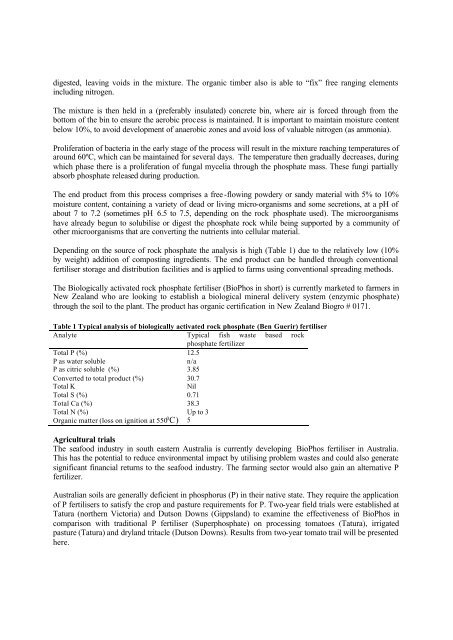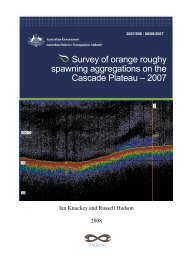Utilisation of seafood processing waste - Fishwell Consulting
Utilisation of seafood processing waste - Fishwell Consulting
Utilisation of seafood processing waste - Fishwell Consulting
Create successful ePaper yourself
Turn your PDF publications into a flip-book with our unique Google optimized e-Paper software.
digested, leaving voids in the mixture. The organic timber also is able to “fix” free ranging elements<br />
including nitrogen.<br />
The mixture is then held in a (preferably insulated) concrete bin, where air is forced through from the<br />
bottom <strong>of</strong> the bin to ensure the aerobic process is maintained. It is important to maintain moisture content<br />
below 10%, to avoid development <strong>of</strong> anaerobic zones and avoid loss <strong>of</strong> valuable nitrogen (as ammonia).<br />
Proliferation <strong>of</strong> bacteria in the early stage <strong>of</strong> the process will result in the mixture reaching temperatures <strong>of</strong><br />
around 60ºC, which can be maintained for several days. The temperature then gradually decreases, during<br />
which phase there is a proliferation <strong>of</strong> fungal mycelia through the phosphate mass. These fungi partially<br />
absorb phosphate released during production.<br />
The end product from this process comprises a free -flowing powdery or sandy material with 5% to 10%<br />
moisture content, containing a variety <strong>of</strong> dead or living micro-organisms and some secretions, at a pH <strong>of</strong><br />
about 7 to 7.2 (sometimes pH 6.5 to 7.5, depending on the rock phosphate used). The microorganisms<br />
have already begun to solubilise or digest the phosphate rock while being supported by a community <strong>of</strong><br />
other microorganisms that are converting the nutrients into cellular material.<br />
Depending on the source <strong>of</strong> rock phosphate the analysis is high (Table 1) due to the relatively low (10%<br />
by weight) addition <strong>of</strong> composting ingredients. The end product can be handled through conventional<br />
fertiliser storage and distribution facilities and is applied to farms using conventional spreading methods.<br />
The Biologically activated rock phosphate fertiliser (BioPhos in short) is currently marketed to farmers in<br />
New Zealand who are looking to establish a biological mineral delivery system (enzymic phosphate)<br />
through the soil to the plant. The product has organic certification in New Zealand Biogro # 0171.<br />
Table 1 Typical analysis <strong>of</strong> biologically activated rock phosphate (Ben Guerir) fertiliser<br />
Analyte Typical fish <strong>waste</strong> based rock<br />
phosphate fertilizer<br />
Total P (%) 12.5<br />
P as water soluble<br />
n/a<br />
P as citric soluble (%) 3.85<br />
Converted to total product (%) 30.7<br />
Total K<br />
Nil<br />
Total S (%) 0.71<br />
Total Ca (%) 38.3<br />
Total N (%) Up to 3<br />
Organic matter (loss on ignition at 550 0 C) 5<br />
Agricultural trials<br />
The <strong>seafood</strong> industry in south eastern Australia is currently developing BioPhos fertiliser in Australia.<br />
This has the potential to reduce environmental impact by utilising problem <strong>waste</strong>s and could also generate<br />
significant financial returns to the <strong>seafood</strong> industry. The farming sector would also gain an alternative P<br />
fertilizer.<br />
Australian soils are generally deficient in phosphorus (P) in their native state. They require the application<br />
<strong>of</strong> P fertilisers to satisfy the crop and pasture requirements for P. Two-year field trials were established at<br />
Tatura (northern Victoria) and Dutson Downs (Gippsland) to examine the effectiveness <strong>of</strong> BioPhos in<br />
comparison with traditional P fertiliser (Superphosphate) on <strong>processing</strong> tomatoes (Tatura), irrigated<br />
pasture (Tatura) and dryland tritacle (Dutson Downs). Results from two-year tomato trail will be presented<br />
here.




